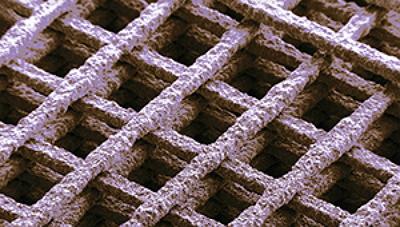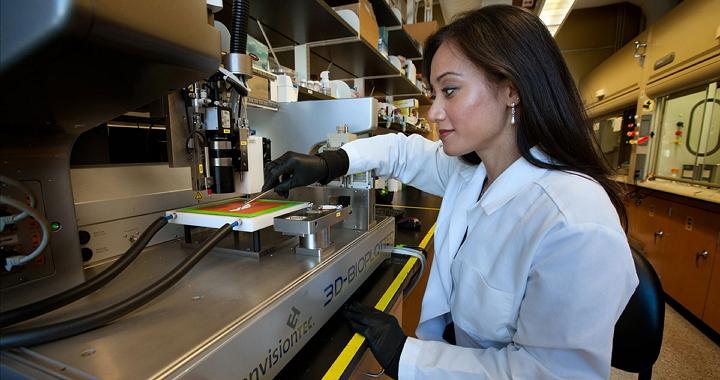 What if you could 3D print a brain or a working neurosystem? It’s not outside the realm of the possible – at least in a structural sense – as a new graphene-nanoflake ink has just been used to print strong 3D structures which resemble neurons in shape and electrical conductivity.
What if you could 3D print a brain or a working neurosystem? It’s not outside the realm of the possible – at least in a structural sense – as a new graphene-nanoflake ink has just been used to print strong 3D structures which resemble neurons in shape and electrical conductivity.
A team of Northwestern University researchers at the Shah TEAM has developed a 3D printed, graphene scaffold which not only supported stem cells, but allowed them to divide and form patterns much like neurons.
Perhaps most importantly, the cells managed to promulgate effectively without the use of additional growth factors or reagents, and the researchers say that means the process will be less expensive.
 The group at Northwestern is led by Dr. Ramille Shah, an assistant professor of materials science and engineering at the McCormick School of Engineering and of surgery at the Feinberg School of Medicine. Also led by postdoctoral fellow Adam Jakus, the project resulted in a method in which he and Shah used graphene “nanoflakes” to build scaffolding and a biocompatible elastomer that provides the structures with critical strength.
The group at Northwestern is led by Dr. Ramille Shah, an assistant professor of materials science and engineering at the McCormick School of Engineering and of surgery at the Feinberg School of Medicine. Also led by postdoctoral fellow Adam Jakus, the project resulted in a method in which he and Shah used graphene “nanoflakes” to build scaffolding and a biocompatible elastomer that provides the structures with critical strength.
“It’s a liquid ink,” Shah explained. “After the ink is extruded, one of the solvents in the system evaporates right away, causing the structure to solidify nearly instantly,” Shah says. “The presence of the other solvents and the interaction with the specific polymer binder chosen also has a significant contribution to its resulting flexibility and properties. Because it holds its shape, we are able to build larger, well-defined objects.”
According the Shah, it may well be the electrical conductivity of the graphene material that contributes to the biological suitability of the lattice. Many attempts to use graphene as a material in 3D printing applications have contained approximately 20% graphene in a polymer composite, watering down graphene’s strength because higher concentrations create too brittle a material. Made of some 60-70% graphene, the Shah TEAM’s “bioink” becomes both flexible and strong.
“Cells conduct electricity inherently – especially neurons. So if they’re on a substrate that can help conduct that signal, they’re able to communicate over wider distances,” Shah says.
The paper the team wrote on the subject, “Three-Dimensional Printing of High-Content Graphene Scaffolds for Electronic and Biomedical Applications”, describes the process and hints at the possible future of the process in fabricating tissues and organs.
According to Shah, the many different types of tissues mean there’s a need for various types of inks.
“We’ve expanded that biomaterial tool box to be able to optimize more mimetic engineered tissue constructs using 3D printing,” she says.
Graphene is an amazing material which features high electrical conductivity, the capability to store energy and it can be used to build incredibly strong and lightweight structures.
The research was funded in part by a McCormick Research Catalyst Award and a Google Gift, and it included the work of lead author Jakus and Mark Hersam, a professor of materials science and engineering at McCormick.
Shah and her team made waves earlier in the year when they announce they’d developed a large group of other printable bioink formulations which also feature properties which make them compatible materials for fabricating tissue and organ structures. In that project, Shah and her team demonstrated the possibility of building cell-compatible, water-based printable gels which can be used to make 3D structures. The Shah TEAM has been making news for graphene inks and even 3D printed fuel cells.
What do you think about the idea of building actual neurons using this graphene-based bioink? Let us know in the Graphene and BioElastomer Inks forum thread on 3DPB.com.
Subscribe to Our Email Newsletter
Stay up-to-date on all the latest news from the 3D printing industry and receive information and offers from third party vendors.
Print Services
Upload your 3D Models and get them printed quickly and efficiently.
You May Also Like
3D Printing News Briefs, July 2, 2025: Copper Alloys, Defense Manufacturing, & More
We’re starting off with metals in today’s 3D Printing News Briefs, as Farsoon has unveiled a large-scale AM solution for copper alloys, and Meltio used its wire-laser metal solution to...
3DPOD 260: John Hart on VulcanForms, MIT, Desktop Metal and More
John Hart is a Professor at MIT; he´s also the director of the Laboratory for Manufacturing and Productivity as well as the director of the Center for Advanced Production Technologies....
3D Printing News Briefs, June 28, 2025: Defense Accelerator, Surgical Models, & More
In this weekend’s 3D Printing News Briefs, 3YOURMIND was selected to join an EU Defense Accelerator, and PTC has announced model-based definition (MBD) capabilities within Onshape. Finally, a study out...
EOS in India: AM’s Rising Star
EOS is doubling down on India. With a growing base of aerospace startups, new government policies, and a massive engineering workforce, India is quickly becoming one of the most important...


































